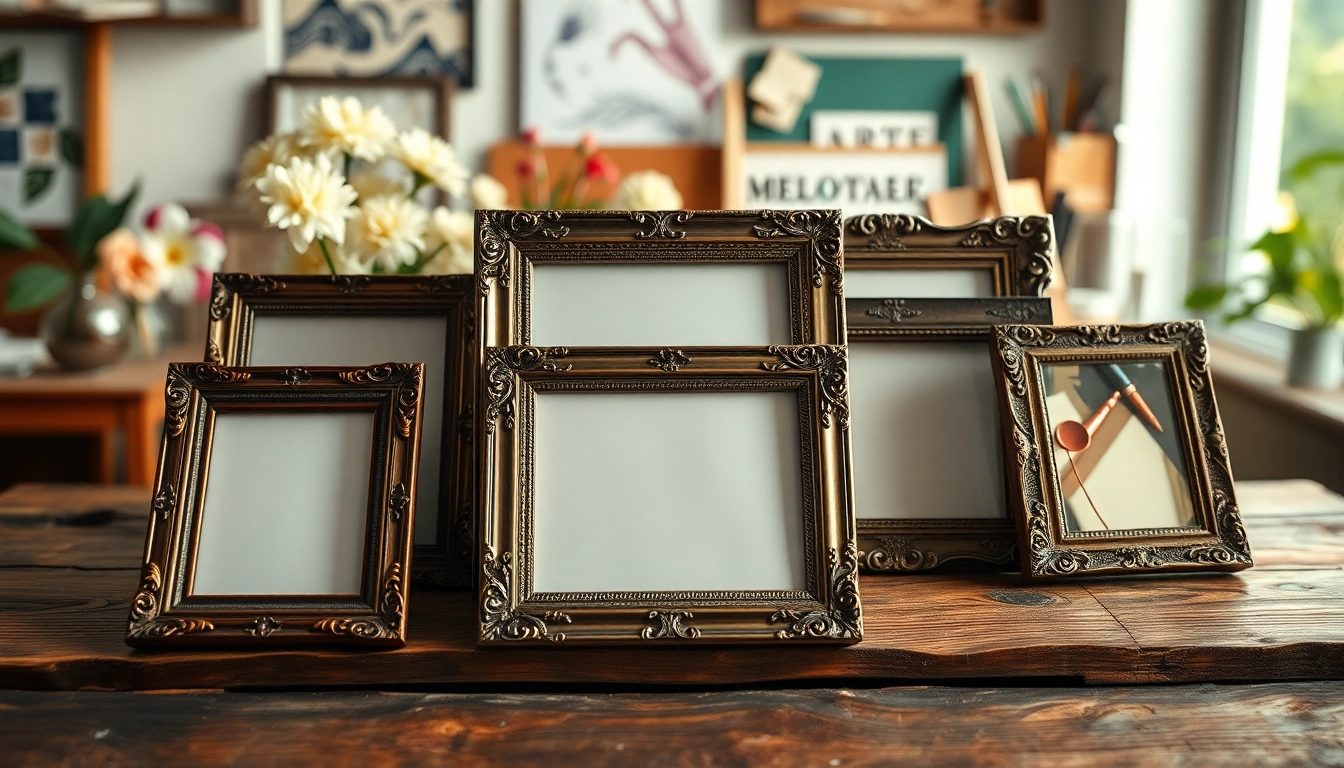Understanding Vintage Frames
What Defines a Vintage Frame?
Vintage frames are more than just simple picture holders; they encapsulate a sense of history and style that new frames often lack. These frames typically range from 20 to 100 years old, and they are a reflection of the art and design sensibilities of their respective eras. The allure of vintage frames lies in their uniqueness, craftsmanship, and the stories they may carry from the past. Many collectors and homeowners choose vintage frames not only for their aesthetic appeal but also for their ability to enrich the decor by infusing spaces with character and warmth.
Key Characteristics of Vintage Frames
Vintage frames exhibit distinct characteristics that set them apart from contemporary options. Here are some key features that define them:
- Material: Many vintage frames are made from wood, metal, or a combination of materials. Common woods include oak, mahogany, and pine, often showcasing intricate carvings or craftsmanship.
- Design: The design typically reflects the era in which the frame was made—Art Deco frames often feature geometric patterns, while Victorian frames might be ornately embellished with floral or scrolling motifs.
- Patina: Over time, vintage frames develop a unique patina that adds to their charm. This aging process typically enhances the frame’s character.
- Size and Shape: Vintage frames come in various sizes and shapes, from grand ornate pieces designed for statement artworks to simple frames ideal for smaller photographs.
The History of Vintage Frame Styles
The history of vintage frames is as layered as art itself. Early frame-making can be traced back to the Renaissance when artists and patrons began to understand the value of presentation. Here’s a brief overview of notable styles:
- Renaissance Frames: Characterized by elaborate carvings and gold leaf gilding, these frames often adorned religious works and portraits.
- Baroque Frames: Known for their dramatic flair, Baroque frames are ornate and often feature dramatic curves and flourishes, typically originating from the 17th century.
- Victorian Frames: Popular during the 19th century, these are often heavy and richly decorated, reflecting the opulence of Victorian decor.
- Art Deco Frames: Emerging in the early 20th century, Art Deco frames present sleek lines, geometric shapes, and a sense of modernity.
Choosing the Right Vintage Frame
Factors to Consider When Selecting Vintage Frames
Choosing the right vintage frame for your artwork or photographs requires thoughtful consideration. Here are several factors to keep in mind:
- Artwork Size: Ensure the frame complements the dimensions of your artwork. Oversized frames can overshadow the piece, while undersized frames can detract from its appeal.
- Style Compatibility: Select a frame that enhances the style of the artwork; a modern piece might require a minimalistic frame, while an abstract painting may benefit from a more intricate style.
- Condition: Check the frame for structural integrity. Look for cracks, loose joints, or significant wear that could affect its longevity and appearance.
- Cost: Vintage frames can vary widely in price. Determine your budget beforehand to narrow down your options efficiently.
Matching Vintage Frames with Your Decor
Incorporating vintage frames into your decor requires an eye for design. Here’s how to harmonize them with your existing style:
- Color Palette: Integrate frames that have colors aligning with your room’s palette. A gold frame could complement neutral walls, while a distressed white frame might add a rustic touch to a modern aesthetic.
- Theme: If your space follows a specific theme (like bohemian or industrial), choose frames that echo those elements. For instance, mismatched antique frames can enhance a boho chic decor.
- Groupings: Create visual interest by grouping frames of varying sizes in a grid format on a wall, or mix and match styles for a more eclectic feel.
Common Materials Used in Vintage Frames
Understanding the materials used in vintage frames can inform your selection process. Here are some frequently seen options:
- Wood: Solid wood frames offer durability and a range of finishes that can either be natural or lacquered. Look for hardwoods like oak for longevity.
- Metal: Metal frames (such as brass or wrought iron) can lend a more modern or industrial look to vintage decor.
- Composite Materials: Not all vintage frames are solid; some may use composite materials that mimic wood or metal appearances, often seen in frames from the mid-20th century.
Where to Find Authentic Vintage Frames
Best Online Retailers for Vintage Frames
For those who prefer online shopping, several retailers specialize in vintage home decor, including frames. These platforms often provide extensive selections:
- Etsy: A marketplace for handmade and vintage items, Etsy features many sellers offering unique vintage frames.
- eBay: This auction platform provides opportunities to buy both vintage and antique frames, often at competitive prices.
- Chairish: A curated online marketplace, Chairish presents a stylish array of vintage frames, ensuring quality and genuine items.
Thrift Stores and Flea Markets for Vintage Treasure
For the adventurous, thrift stores and flea markets are fantastic venues to discover vintage frames. A few tips for success include:
- Be Patient: Finding the right frame may take time, so be persistent and check back frequently.
- Examine Carefully: Inspect each frame for damage and missing components before purchasing to avoid future disappointment.
- Negotiate Prices: In many flea markets, haggling is expected, so don’t hesitate to negotiate for a better price.
Identifying Genuine Vintage Frames
When searching for vintage frames, it’s essential to discern between authentic vintage pieces and reproductions. Here are some tips to help:
- Look for Markings: Many vintage frames have maker marks or labels that can indicate authenticity and value.
- Research Styles: Familiarize yourself with the defining characteristics of different vintage styles to help authenticate potential acquisitions.
- Consult Experts: In uncertain cases, consult with vintage decor experts or appraisers to validate the authenticity of a frame.
Styling Tips for Vintage Frames
Creating an Art Gallery Wall with Vintage Frames
A gallery wall is an excellent way to showcase art with vintage frames, enhancing the room’s visual impact. Here’s how to achieve a striking display:
- Select a Focal Point: Choose a central artwork to anchor your display, then arrange frames around it in a way that balances the overall look.
- Mix Sizes and Shapes: Combine various frame sizes and styles for an eclectic yet cohesive appearance. This contrast can create a more dynamic visual flow.
- Plan Your Layout: Lay frames on the floor first to experiment with arrangements before hanging; this trial and error can save time and effort.
Pairing Vintage Frames with Modern Decor
The juxtaposition of vintage frames against modern decor can create an interesting contrast. Below are tips for blending the two:
- Choose Minimalistic Frames: Opt for streamlined vintage frames that complement modern aesthetics without overpowering them.
- Color Coordination: Use frames that share colors or tones with your modern decor to tie the styles together seamlessly.
- Balance Design Elements: Make sure to balance the vintage frames with other elements in the room, such as furniture or lighting, to maintain visual harmony.
Incorporating Vintage Frames in Different Rooms
Vintage frames can enhance the ambiance of any room. Here are a few ideas for different spaces:
- Living Room: Create a focal point above a sofa with a cluster of vintage frames encapsulating artwork reflective of personal experiences or treasured memories.
- Bedroom: Frame personal photographs in vintage frames and create a small collage on a bedside table, adding a nostalgic touch.
- Home Office: Display diploma and achievements in vintage frames to invoke motivation while providing a sophisticated look.
Caring for Your Vintage Frames
Cleaning and Maintenance Tips for Vintage Frames
Maintaining vintage frames is crucial for preserving their integrity. Here are essential cleaning tips:
- Gentle Dusting: Use a soft, lint-free cloth to gently remove dust from frames. Avoid using water or cleaners that can cause wood and finishes to deteriorate.
- Dealing with Stains: If your frame is stained, consult a restoration expert. DIY methods may risk further damage.
How to Restore Vintage Frames
When it comes to restoring vintage frames, consider the following steps:
- Assess the Damage: Determine whether the frame needs minor cosmetic touch-ups or extensive restoration.
- Repair Cracks: Use wood glue or epoxy for solid wood frames. Carefully fill in cracks to maintain stability and appearance.
- Refinish: For frames that have lost their finish, lightly sand and refinish according to the frame’s material requirements.
Protecting Vintage Frames from Damage
Preventative care is paramount in protecting your vintage frames. Consider these protective measures:
- Avoid Direct Sunlight: Keep frames away from direct sunlight to prevent fading and warping over time.
- Use UV-Protective Glass: If framing art pieces, employ UV-filtering glass to safeguard artworks from light exposure.
- Store Properly: If you’re not displaying a frame, store it upright in a dry, temperature-controlled space. Consider using protective covers to prevent scratches.


